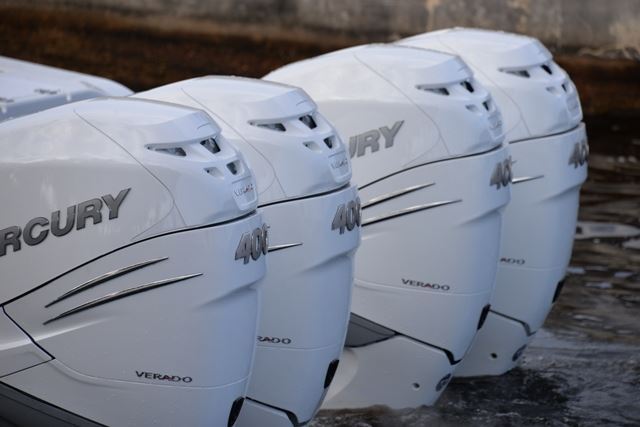
After making a big splash in 2018 with the release of 25 new engines, you might think Mercury Marine would be a little quiet this year in Miami. Of course if you believe for even a moment Mercury wouldn’t have some big news to share on the opening day of the Miami International Boat Show, you probably don’t know this global manufacturer as well as you think you do. Innovation is in its DNA, and as Mercury celebrates its 80th anniversary this year, it’s clear they have no plans of slowing down anytime soon.
The gates officially opened this morning in Miami at the annual February boat show that is touted as the best five days of boating. While the rest of the world may be focused on Valentine’s Day, Mercury showed the industry some love by releasing the new Verado 400 hp four-stroke. The engine manufacturer has gone to great lengths to not only create a powerful and lightweight design, but also to reduce the noise and vibration for a smooth and quiet ride.
Prior to the show, select members of the boating media were given the opportunity to test and review the Verado as well as the other new products being released today. This was all done at Lake X in Florida, Mercury’s private and secluded testing facility, which is as rich in history as it is in tradition.
Barletta 400
The new 400 hp outboard was on a variety of boats, including the Barletta L25UC pontoon. Key features on the model included Mercury’s Active Trim that automatically (and perfectly) trims your engine, power steering and SC1000 gauges, plus you can keep an eye on all your information through the VesselView mobile app on your smartphone.
The new Verado is available in four different colors: traditional Phantom Black and three shades of white — Pearl Fusion White, Cold Fusion White and Warm Fusion White. On this model the black engine tied in perfectly with the black-paneled Barletta.
At full throttle (6700 RPMs) we reached a top speed of 53.3 mph on this 27-foot pontoon, and what impressed us most was the zero-to-20 mph time of just 3.87 seconds. Now that’s some serious acceleration, but what else would you expect from having a single 400 hp engine on the back with a dry weight of just 668 pounds? At a cruising RPM of around 3500 you’re looking at nearly three miles per gallon, giving you a range of approximately 140 miles on a full 47-gallon tank of fuel.
After putting the throttle down, we were thoroughly impressed with this new outboard. There will always be a place for the Mercury 400R, the racing engine that has grown in popularity since being released, but there is something about this quiet, yet powerful 400 Verado that seems to be the right fit for pontooners on the Great Lakes.
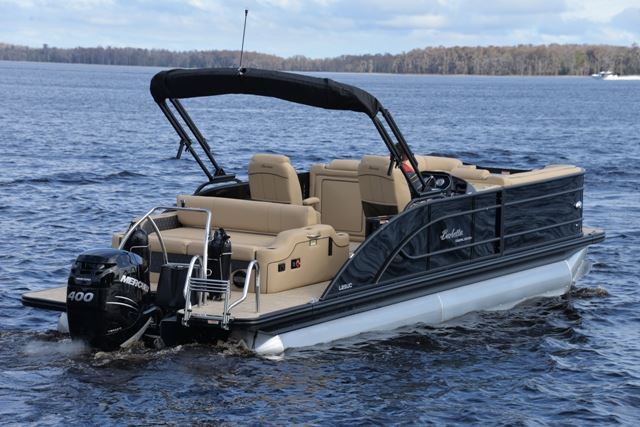
Power Products
The other big news here in Miami is the debut of the Harris 250 Grand Mariner. No, this isn’t a new model for Harris, but it does showcase what happens when top-of-the-line technology all comes together on a boat. In July, Mercury Marine’s parent company, Brunswick, acquired Power Products, which included brands such as Ancor, BEP, Blue Sea Systems, CZone, Del City, Lenco Marine, Marinco, Mastervolt, Park Power, Progressive Industries and ProMariner.
The company’s motto, “Powering Innovation, Connecting with Customers,” aligns with Mercury Marine’s vision of enhancing the boating experience for its customers and providing opportunities to make boating easier, and that’s clear with this Harris pontoon.
“Power Products provides Mercury a complementary portfolio of products and services, creating a broader and more significant marine business in key categories,” said John Pfeifer, Mercury Marine president. “Power Products has an experienced team with a proven track record of driving innovation in electrical products and systems.”
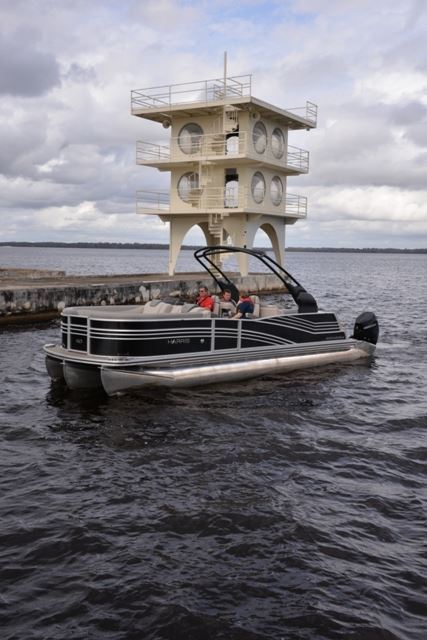
The Loaded Harris
The demo ride on the Grand Mariner began by uttering the common phrase, “Hey Siri,” and after asking the voice-controlled personal assistant to start the engines, the twin 300 V8s began to purr. How’s that for an advancement in technology! The simplified one integrated system made this Harris a popular choice for journalists during our weekend of testing. Technologies such as CZone digital control and monitoring truly simplify the operation of your pontoon. It gives you complete control of all electrical functions with the touch of a button. We were able to control the lights, stereo and other functions with ease. Plus CZone has a proven reputation for reliability with over 10 years of experience in marine installations.
Other key features on this Harris included Mercury’s VesselView, a multi-function display that has more information and data on boat and engine functions than you’re going to find anywhere else including rpm, speed, fuel flow and efficiency, temperature, trim and more. With direct integration into Mercury’s propulsion systems, VesselView has the ability to control the engine. Features such as trolling for fish, pulling tubers, adjusting skyhook, setting cruise control and others can be easily controlled from the VesselView screens. And if you’re not an expert, don’t worry. VesselView will make you feel like you’re one. And if that’s not enough, VesselView Mobile brings all that power to your mobile device as well as even more ways to stay connected.
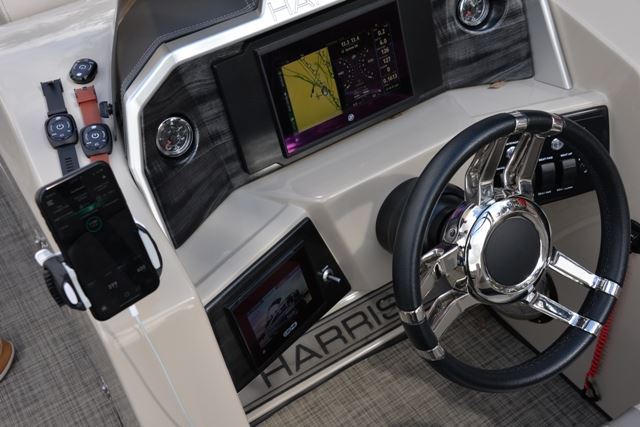
MOB
Another new technology we were able to experiment with on this pontoon came from a partnership with FELL Marine, a leader in marine wireless technology. Mercury Marine co-develops exclusive wireless and IOT connected products that seamlessly integrate with Mercury’s SmartCraft suite of digital technology and CZone digital switching, to make boating easier, safer and more enjoyable than ever before.
Utilizing a wearable FOB, in the event of a Man-Over-Board (MOB) situation, the engines turn off and an alarm sounds. Emergency contacts can also be programmed to be contacted after a specific time that you set, and another safety feature we like is the lights on the boat start blinking “SOS” as an added precaution. If it was a passenger who fell over, the engines can be started immediately to return to the location that was automatically marked on the screen.
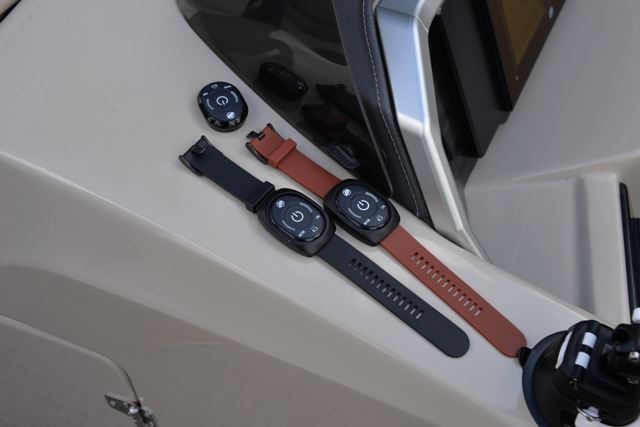
Assisted Docking
The assisted docking system that is based on aerospace control systems and autonomous-car artificial intelligence, was another exciting announcement Mercury announced prior to the Miami Boat Show. At Lake X, the system was demonstrated on a Boston Whaler 330 Outrage with twin Mercury Verados and Joystick Piloting for Outboards.
Mercury collaborated with Raymarine to incorporate Raymarine’s DockSense system, which uses vision technology to sense and identify potential obstacles on the boat’s course, providing feedback to the Mercury autonomous system to allow the JPO system to respond.
“We’re able to provide a product that makes it simple and easy to dock a boat without hitting anything,” added Pfeifer. “This will ultimately turn into an automatic-docking product.”
It’s the industry’s first intelligent object recognition and motion sensing assisted docking solution, and with DockSense, it continuously monitors the vessel’s surroundings, keeping the autonomous system updated with real-time detection of objects like pilings or another vessel.
As journalists, we each took a turn attempting to run into a nearby dock or seawall, and the system simply overrides you and won’t allow you to do it. As we were just idling and talking, we got within the preset radius of a dock, and the engines automatically revved up and kept us at a safe distance. When we were ready to dock, we simply pressed a button to turn off the sensor on one side and then used the Joystick to perfectly line us up.
The DockSense system includes multiple FLIR machine vision cameras, a central processing module and the DockSense app running on Raymarine’s Axiom navigation display. It’s still being developed, but it does bring some excitement to what we can expect in the future.
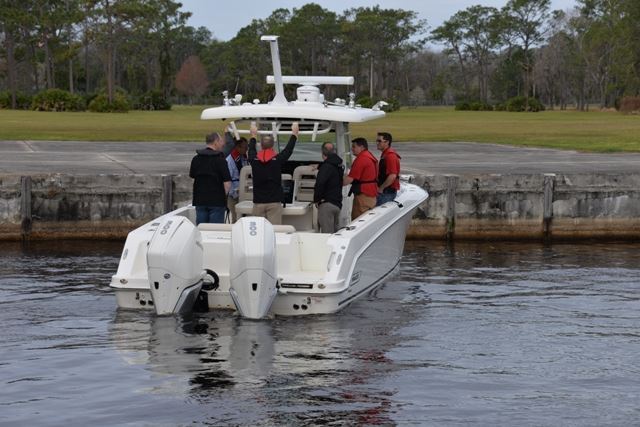
Propane Power
Last but not least, unless you’re referring to horsepower, Mercury also released the 5 hp propane outboard. We were able to try it out as well, and it runs clean, starts easy and is of course environmentally friendly. With just a one-pound cylinder propane bottle, the outboard can run for 30 minutes at full throttle or 1.4 hours at half throttle. If using a 20-pound propane tank, the range is 10 hours at full throttle or 22 hours at half.
What’s next for Mercury Marine? Only time will tell, but one thing is for sure: this company is constantly on the move, and its 80th celebration is off to a great start!
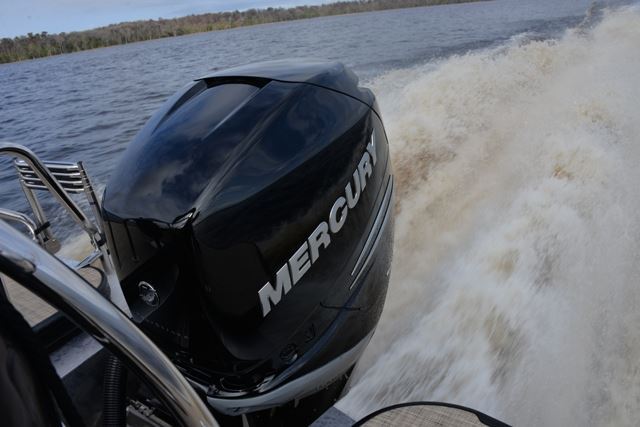
For More Information:
Mercury Marine
Barletta
FELL Marine
Harris Pontoon Boats
Power Products
Raymarine

